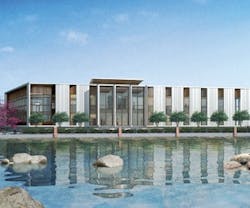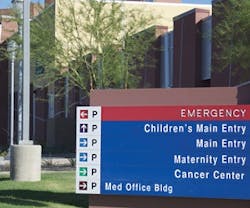Newsworthy
Eleni Reed Takes on Sustainability at GSA
How do you green 354 million square feet? This is the challenge that faces the General Services Administration's (GSA) first Chief Greening Officer, Eleni Reed. GSA's buildings represent a diverse portfolio with 8,600 leased and 1,500 owned properties, ranging from courthouses and post offices to border stations and federal buildings. Reed's role reinforces GSA's commitment to sustainability and ensures green technologies and practices are incorporated into modernization projects.
The agency's challenge is to create long-lasting workplaces for a million federal employees while "eliminating all damage to the environment resulting from its operations." It already has a strong green foundation with 40 LEED-certified buildings. Reed's task, however, will help the agency reach its goal of having the most sustainable real estate organization in the U.S.
Driving Sustainability
The key to this ambitious undertaking starts with GSA's attitude toward sustainability. Reed specifies, "real estate plays a key role in addressing global environmental issues, such as climate change and the depletion of natural resources, through designing, constructing, maintaining, and operating high-performance green buildings." Reed's office works in partnership with a host of organizations throughout the building industry. These connections "will be instrumental in driving innovative sustainability practices – both technological and operational – and in the process, foster market transformation," says Reed.
Prioritizing
Short term goals include modernizing federal buildings designated under the American Recovery and Reinvestment Act, which allotted $5.5 billion to GSA. The mandate gives the agency the ability to push the envelope by "more aggressively seeking new, innovative technologies," says Reed. Renovations are well underway throughout 264 buildings across the country.
Benchmarks
Before a project is started, extensive life-cycle cost analyses are performed to determine if new construction or a renovation is the most effective option. To ensure legislative and sustainability goals are fulfilled, a Minimum Performance Criteria (MPC) checklist is required for all projects. The list targets integrated design, energy consumption, renewable energy generation, water consumption, stormwater runoff, indoor environment quality, and materials use and disposal.
Smart Grid Initiatives
To reduce energy loads, GSA is pursuing multiple options for a smarter grid. Ten percent of its annual energy consumption is offset by renewable energy. In addition, five locations have received cogeneration plants (combined heat and power), with a total capacity of 12,720kW. Advanced electricity meters, which provide real-time energy consumption data, are also used to reduce peak demands and address performance. Where possible, major building systems are integrated into one network for greater control and flexibility in automated and behavior-driven policies.
Forward-looking Practices
Net zero buildings, which harvest energy on-site without tapping into the local grid, will aid in offsetting energy consumption. "Such buildings will contribute to GSA's energy and carbon reduction goals, as well as position the agency to interact with the macro grid as it progresses to become a Smart Grid," says Reed. One is being constructed as a port of entry in New Mexico.
An HVAC system using chilled beams is being installed in a new federal courthouse in Bakersfield, CA. "It will be the first courthouse in the country to utilize this technology and we estimate a 6 percent performance improvement over a normal HVAC system. The building will use 44 percent less energy than a normal (ASHRAE 90.1) building design," Reed explains. Achieving a zero footprint by 2030 will be no easy feat – however, Reed's leadership will ensure GSA's goal comes to fruition.
Health Care Needs Sustainability ManagersA recent health care survey indicates that appointing a sustainability manager is an important step in retooling for sustainability.
Inefficiencies built into office buildings take a toll on lost productivity and added costs, according to the IBM Smarter Buildings study (a survey of more than 6,000 office workers in 16 U.S. cities).
Hospitals need a sustainability manager – according to a recent survey conducted by the IFMA Health Care Council and the Corporate Realty, Design & Management Institute (CRDMI). Nearly three of four respondents believe hospitals need a sustainability manager – a trend that stood out in the survey.
Among the survey's key findings:
- Everyone thinks energy costs are going up, the question is how high?
- Nearly all (94 percent) of respondents say that green washing is worse than ever.
- A big worry is that new technology may not perform as expected.
- Reliability of infrastructure is a large concern.
- Evidence-based design (the process of basing decisions about the built environment on credible research to achieve the best possible outcomes) is employed occasionally by two-thirds, and nearly always by one-third.
- Midwestern health care professionals think they're just as sustainable as other industries. The opposite is true in Sunbelt cities, where professionals say that health care is doing worse in sustainability than other industries.
Nearly 80 percent of participants say that "initial cost" takes precedence in the final selection of equipment and materials on recent projects. More than 90 percent of respondents waved red cards at manufacturers and suppliers, saying green washing is more prevalent than two years ago.
Almost three-quarters occasionally research scientific sources when selecting products or equipment, while almost one-quarter almost always or always do this.
The survey was conducted as part of a seminar series on "Energy, Economics & Environment: Making the 3Es Work together in Health Care." Results can be downloaded at www.squarefootage.net.
Green is Good, but Colorful is BetterLush, colorful, and tropical foliage is the new trend in workplace greenery, says Ambius. "Clients are seeking to establish a welcoming and restorative mood with their office plants this season," says Todd Ferguson, area managing director for Ambius. "Vibrant and colorful plants at the workplace imbue a more relaxed summer vibe that clients are craving this season."
The top five most requested workplace plants and plant varieties for the American marketplace currently include:
- Pygmy Date Palm Tree. This tree can grow up to 10 feet high and sports a slender trunk with bright green pinnate leaves that grow from the top of the trunk.
- California Ivy/English Ivy. These plants can be trained to climb up walls or live inside hanging baskets. They feature a medium-sized, deep green ivy leaf.
- Orchids. This plant family's many species feature showy and beautiful flowers that make an elegant statement in any workplace environment.
- Kalanchoe. There are more than 125 species in this plant class, featuring tropical, succulent flowering plants that add color and panache to office cubicles. Flowers form little clusters and come in a variety of shades of red, orange, yellow, and purple.
- Aspidistra Elatior. This Asian-native plant is commonly known as the "cast-iron plant" or "iron plant." It sports large, leathery leaves.
"It isn't necessary to fill every available space with a plant to achieve a curative interior landscape," explains Ferguson. "Often just a few good-quality specimens located where employees work or take their rest breaks can be sufficient. Being around plants certainly seems to reduce stress and engender a feeling of well-being in most people, a benefit that is even more acute if correct lighting is in place. The fact that a workplace has budgeted on something to make the environment more attractive may also be a contributing factor, by sending a signal to staff that management cares about its employees."
Auraria Science Building Achieves Community Connection and LEED-Gold
The Auraria Higher Education Center (AHEC) in Denver had a special challenge when they started construction on a new science building. Not only did the facility need to meet the academic needs of three institutions, it also had to close the gap between the urban campus and its downtown community. The solution was to use a "7"-shaped design to maximize the location on a busy boulevard.
With more than 59,000 cars passing daily, the Auraria Science Building's glass facade offers the public an uninterrupted view of brightly colored corridors and lounge spaces while students and staff have quality views of green spaces and other campus buildings. This transparency was maximized by soffits that pull the interior walls away from the window system. Construction efforts depended on regionally manufactured materials – 20 percent of which were produced within 500 miles – and diverted 75 percent of construction waste from landfills. The 197,000 square foot facility recently achieved LEED-Gold. In addition to research labs and classrooms, the building also houses a nursing mothers suite, a greenhouse, animal lodging, and a cadaver room. The layout also gives the center the ability to accommodate a future enrollment growth of up to 50 percent.
"Buildings have a unique power to improve the way people think about spaces and places," says Barbara Weiske, AHEC Interim Executive Vice President for Administration. "Thanks to the new science building and its powerful design, downtown and the Auraria campus have a new collaboration and a new connection."
EPA Approves Data Centers for ENERGY STAR Label
The U.S. Environmental Protection Agency (EPA) announces that stand-alone data centers and buildings that house large data centers can now earn the ENERGY STAR label. Data centers must be in the top 25 percent of their peers in energy efficiency, according to the EPA's energy performance scale.
Data centers use a significant amount of energy, accounting for 1.5 percent of total U.S. electricity consumption at a cost of $4.5 billion annually, an amount that is expected to almost double over the next five years. Based on the latest available data, improving the energy efficiency of data centers by just 10 percent would save more than 6 billion kilowatt-hours each year, enough to power more than 350,000 homes and save more than $450 million annually.
Data centers can improve energy efficiency in many ways, such as purchasing ENERGY STAR qualified servers and ensuring that all HVAC equipment functions properly. Through Energy Star, the EPA provides a proven energy management strategy and free tools for public and private organizations to save energy and money through increased energy efficiency.
Lack of Data Stalls Greening
The lack of green retrofits could be due to the lack of data, not the lack of desire. It is believed that these retrofits save money and reduce costs; but according to Gary Hattem, president of the Deutsche Bank Americas Foundation, the lack of data could be the biggest obstacle to going green.
"This problem is found in many industries," says Cynthia Schultz, COO of Sustainable Dashboard Tools, LLC. "Everyone suspects there are savings, but there are few measurable tools available to prove it."
If building or business owners are armed with green and sustainable data when seeking financing, it would help them get financing because the banks could see that becoming green and sustainable can improve the bottom-line, says Kenneth Horn, a building developer in New York City. B




